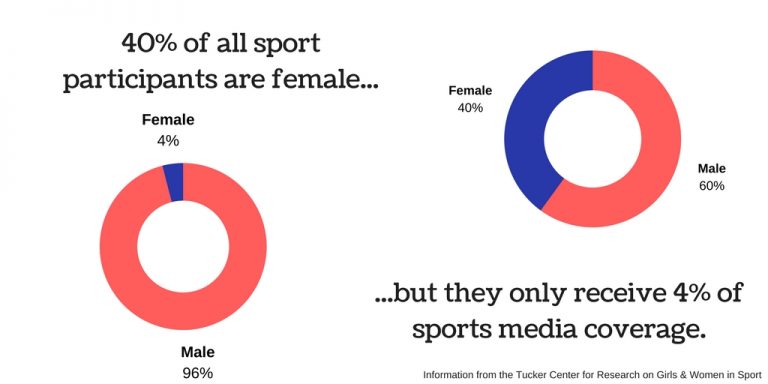By Yurika Saiki
The wage gap is one of the most serious issues of gender discrimination in sports

“One of the essential conditions for the effective exercise of human rights is that everyone should be free to develop and preserve his or her physical, intellectual, and moral powers and that access to physical education and sport should consequently be assured and guaranteed for all human beings.†This is written in the International Charter of physical Education and Sports, adopted in 1978 by UNESCO. It means playing sports and physical activities are recognized as human rights, so both males and females have the righto play sports equally. Although, gender discrimination exists in sports, the situation has improved gradually in recent years, and there are now many famous women athletes, such as Serena Williams, Simon Biles, and Alex Morgan. However, the sports world is still dominated by men, and women athletes continue to encounter unequal treatment. It can be considered an important social problem of the present day. Gender discrimination in sports appears in three main ways: the wage gap, media coverage and stereotypes.
The wage gap is one of the most serious issues of gender discrimination in sports, and it can be verified by countless examples. In the ranking of the “World’s 100 Highest-Paid Athletesâ€, there is just one woman, Selena Williams. Tennis is said to the most profitable sport for female athletes.
In the ranking of the “World’s 100 Highest-Paid Athletes,†there is just one woman, Selena Williams.
Nevertheless, there is a big wage gap. Compare William’s prize money to that of men’s number one player, Navak Djokovic’s. Djokovic earned approximately $256,000 per victory and Williams $219,000 even though both players won three grand slams. It is a significant difference. Another example is in soccer. It has a significantly large difference in payment. According to Forbes magazine, the U.S men’s team collected $9 million dollars in the World Cup soccer victory 2014, but the U.S. Women’s team earned only $2 million for their 2015 women’s world Cup soccer victory. It was four times less money. The gap becomes bigger when the total prize money is considered. In the total payments of FIFA, women’s World Cup team earned $15 million, and men’s team earned $576 million. It was almost 40 times larger. Furthermore, former England captain Wayne Rooney took home a $400,000 a week, but his female counterpart, Steph Houghton, only took home $1,600 a week, according to Ladbrokes Sports. The final example is in basketball. There is a pay disparity between the NBA and the WNBA. The league minimum in the NBA this season is $525,000, but the WNBA league minimum last summer was $38,000. The WNBA regular season is 34 games, compared with the NBA’s 82 games. However, the highest-paid player in WNBA makes approximately one-fifth that of the lowest-paid player in the NBA. Two years ago, 52 players in the NBA each earned more than all of the players in the WNBA combined. I cited several cases that relate to wage gap in sports. However, these only a small part of it.

Source: Tucker Center for Research on Girls and Women in Sports
The media coverage of women is also a serious problem of gender discrimination in sports. Compared with men’s sports, women’s sports clearly receive lesser airtime. There are several statistics that prove that women in sports are generally neglected and given little importance when it comes to media coverage. According to the Tucker Center for Research on Girls and Women in Sports, although approximately 40% of sport and physical activity participants are women, women’s sports receive only 4% of all sports media coverage. In addition, women-only sports stories totaled just 3.5% of all sports stories in a study of four major newspapers (USA Today, the Boston Globe, the Orange Country Resister and the Dallas Morning news.)
Although approximately 40% of sport and physical activity participants are women, women’s sports receive only 4% of all sports media coverage. In addition, women-only sports stories totaled just 3.5% of all sports stories in a study of four major newspapers.
Such low coverage of women’s sports like these leads to less viewership and a smaller fan base. Furthermore, these things result in less advertisement and less sponsors, and these are connected with lesser pay. The problem is not only the amount of the media coverage, but also the contentf the stories. Media coverage frequently sexualizes women’s sports. The commentators often focus on athlete’s appearance more than their athletic skills and abilities. One well-known example is the sexualization faced by Serena Williams. After she won her sixth Wimbledon title, social media focused on her body. They commented that she wasn’t feminine enough. At another Wimbledon title the following year, the media focused on her dress. They claimed it was too tight and revealing. Studies show that print references to female athletes comment on makeup, hair, or the shape of their bodies. Although the print journalists almost never make similar comments about male athletes. Media coverage has an enormous influence, so due to such coverage, women’s sports will be taken more lightly.
 Finally, the stereotypes of women athletes are one of the most serious problems and these impact women athlete’s performances. “No matter how toughened a sport woman may be, her organism is not cut out to sustain certain shocks†This statement was said by Boron Pierre de Coubertin who founded the modern Olympics. It implies that women are too weak for sports. The traditional images of women include graceful, obedient, quiet and weak. Even today, women athletes are exposed to a great deal of gender stereotyping. The word “softball†is already indicative of gender stereotyping. Baseball is sometimes called hardball, and it is considered a male sport. The alternative sport for women is softball. It means women sports need to be at a “softer†level than men’s. In addition, the size of the baseball is much smaller than the softball. It implies that women need an easier ball to hit. In other words, women can’t perform at a higher level in comparison with men. It can be considered a type of gender discrimination relating the stereotype of women athletes. In fact, one experiment proved that the negative stereotypes of women athletes affect their performance.
Finally, the stereotypes of women athletes are one of the most serious problems and these impact women athlete’s performances. “No matter how toughened a sport woman may be, her organism is not cut out to sustain certain shocks†This statement was said by Boron Pierre de Coubertin who founded the modern Olympics. It implies that women are too weak for sports. The traditional images of women include graceful, obedient, quiet and weak. Even today, women athletes are exposed to a great deal of gender stereotyping. The word “softball†is already indicative of gender stereotyping. Baseball is sometimes called hardball, and it is considered a male sport. The alternative sport for women is softball. It means women sports need to be at a “softer†level than men’s. In addition, the size of the baseball is much smaller than the softball. It implies that women need an easier ball to hit. In other words, women can’t perform at a higher level in comparison with men. It can be considered a type of gender discrimination relating the stereotype of women athletes. In fact, one experiment proved that the negative stereotypes of women athletes affect their performance.
Stereotypes of women athletes are one of the most serious problems, and these impact women athlete’s performances.
A German scientist recruited 30 competitive female soccer players from three different Frankfurt soccer clubs. First, each participant was timed in a dribbling exercise. Second, half of the participants read an article that discussed the increasing worldwide popularity of soccer. The other half of the participants read an article that argued that women are inferior soccer players. Finally, they timed the players dribbling speed again to assess the effects of exposure to negative stereotypes. The result is that women players who read the negative article dribbled more slowly than they did before. This experiment supports the argument that the negative stereotypes have bad influences on players.
In conclusion, today gender discrimination in sports is a serious problem worldwide. It can be explained by three major problems. The first one is the wage gap. Another problem is lesser media coverage and sexist comments by media. The last problem is typical stereotypes of women athletes. Today, playing sports is not only for men, but also for women. In order to decrease gender discrimination in sports, getting rid of separate sports in primary school is one of the important approaches. If we start to take action in early years, equality in sports will finally be realized.
Further Reading
“Gender Discrimination in Sports.†Youth Ki Awaaz. Accessed May 1. 2018. <https://www.youthkiawaaz.com/2011/07/gender-discrimination-in-sports/>.
